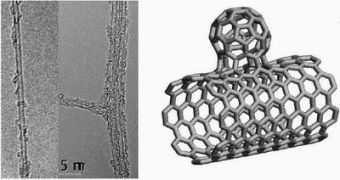The fullerenes, discovered in 1985 by researchers at Rice University, are a family of carbon allotropes named after Richard Buckminster Fuller and are sometimes called bucky balls. They are molecules composed entirely of carbon, in the form of a hollow sphere or ellipsoid.
A carbon nanotube is a one-atom thick sheet of graphite (called graphene) rolled up into a seamless cylinder with diameter of the order of a nanometer. This results in a nanostructure where the length-to-diameter ratio exceeds 10,000. They exhibit extraordinary strength and unique electrical properties, and are efficient conductors of heat. Inorganic nanotubes have also been synthesized.
The newly discovered structures, dubbed NanoBuds because they resemble buds sprouting on branches, are a hybrid carbon nanomaterial that merges the single-walled nanotubes, SWNT, and fullerenes; it may possess properties that are superior to fullerenes and nanotubes alone.
The creation of the NanoBuds began with the synthesis of single-walled carbon nanotubes in a standard reactor. The resulting SWNTs seemed to be coated with clusters of carbon atoms, but a closer investigation, using an electron microscope, revealed that most of the clusters were actually fullerenes.
This deviation from the characteristic fullerene sphere, or "bucky ball," could have been due to the presence of covalently attached oxygen or hydrogen. Further measurements detected oxygen in each NanoBud, and a round of infrared spectroscopy revealed the presence of two types of organic compounds known as ethers and esters. These compounds may act as bridge-like structures connecting the fullerenes to the nanotubes.
Esko Kauppinen, a professor and researcher at the Helsinki University of Technology and the technology development organization VTT Biotechnology, in Finland, said: "Both fullerenes and single-walled carbon nanotubes exhibit many advantageous properties, but despite their similarities there have been very few attempts to physically merge them. The novel hybrid material we discovered merges the two into a single structure, in which the fullerenes are covalently bonded to the nanotubes."
NanoBuds could have many applications as they may find use as memory devices and quantum dots or cold electron field emitters - materials that emit electrons at room temperature under a high applied electric field - due to the fullerenes' many curved surfaces, which make for better emitters that flat surfaces. Cold electron field emission is the key to many technologies, including flat-panel displays and electron microscopes.

 14 DAY TRIAL //
14 DAY TRIAL //